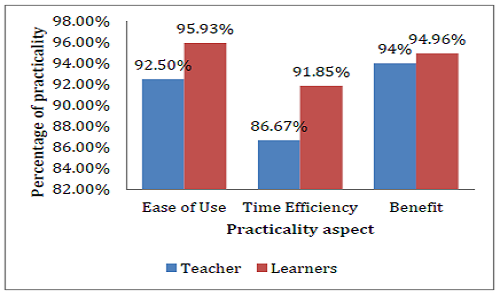
Development of Interactive Powerpoint Learning Media Based on Guided Inquiry on Class XI High School Chemical Equilibrium Material
Abstract
Learning media is one of the supporting factors for achieving learning objectives. One of the learning media used is Powerpoint media. the type of research used is research and development or Research and Development (R&D). This study aims to develop a guided inquiry-based powerpoint interactive learning media on chemical equilibrium material and reveal its validity and practicality as a chemistry learning medium. The development model used in this study is a 4-D model (define, design, develop and disseminate). The stages that are carried out are only up to the develop stage. The study was conducted at SMAN 2 Lubuk Basung. The learning media developed were assessed by 9 validators, and practicality was assessed by 2 chemistry teachers and 27 students of class XII MIPA. Based on the research that has been carried out, it is found that the content validation and construct validation of the learning media developed have a high validity category with the Aiken's V formula of 0.90399 and 0.92857 and the practicality of learning media based on the practicality questionnaire of the teacher's response is 91.05556 and student responses of 94.2469 with very practical category.
Keywords
Full Text:
PDFReferences
Dewi, R. S. (2020). Development of Interactive Powerpoint Learning Media based on Guided Inquiry on Buffer Solution Material. Journal of Multidicsiplinary Research and Development, 3(1), 162–171.
Febriani, A., Elya, B., & Jufri, M. (2016). Activity and Safety Test of Hair Tonic Hibiscus Leaf Extract (Hibiscus rosa-sinensis) on Rabbit Hair Growth. Jurnal Farmasi Indonesia, 8(1), 259–270.
Indriani, A., & Dkk. (2017). Identify learners' difficulties in understanding chemical equilibrium. Jurnal Pembelajaran Kimia, 2(1), 9–13.
Lestari, L., Alberida, H., & Rahmi, Y. L. (2018). Validity and Practicality of Student Worksheets (LKPD) Kingdom Plantae Material Based on Scientific Approach for Participants. Jurnal Eksakta Pendidikan (JEP), 2(11), 170–177.
Lovisia, E. (2018). The Effect of the Guided Inquiry Learning Model on Learning Outcomes. SPEJ (Science and Phsics Education Journal), 2(1), 1–10.
Lufri, Gustinasari, M., & Ardi. (2017). Development of Concept-Based Learning Modules with Examples on Cell Material for High School Students. Bioeducation Journal, 1(1), 60–73.
Moog, R. S., & Farrell, J. J. (2008). Chemistry A Guided Inquiry. America: Bind-Rite Graphics, Ine.
Nomleni, F. T., & Manu, T. S. N. (2018). Development of Audio Visual Media and Teaching Aids in Improving Concept Understanding and Problem Solving. Scholaria. Jurnal Pendidikan Dan Kebudayaan, 8(3), 219–230.
Nugraha, A. G. (2017). Development of Interactive Media Based on Adobe Flash CS4 Professional on Thematic Learning for Grade 2 Elementary School Students. Scholaria, 7(2), 94–105.
Pribady, A. B. (2017). Media and Technology in Learning. Jakarta: Kencana.
Roliza, E., Ramadhona, R., & Rosmery, L. (2018). Practicality of Student Worksheets in Learning Mathematics Statistics Material. Jurnal Gantang, 3(1), 41–45.
Saida, L. N., Wijoyo, S. H., & Wicaksono, S. A. (2019). The Effect of Using Powerpoint-Based Interactive Learning Media to Increase Learning Motivation, Study Habits, and Student Learning Outcomes at SMK Negeri 3 Malang. Jurnal Pengembangan Teknologi Informasi Dan Ilmu Komputer, 3(9), 8695–8705.
Sugiyono. (2015). Educational Research Methods (Quantitative, Qualitative, and R&D Approaches). Bandung: Alfabeta.
Waleulu, A., Muharram, & Sugiarti. (2019). The Effect of the Guided Inquiry Learning Model on Critical Thinking Skills and Student Learning Outcomes. Chemistry Education Review, 3(1), 8–16.
DOI: http://dx.doi.org/10.31258/jes.7.2.p.168-181
Refbacks
- There are currently no refbacks.
Copyright (c) 2023 Tifani Qairani Fitri, Syamsi Aini

This work is licensed under a Creative Commons Attribution 4.0 International License.
Publisher: FKIP Universitas Riau












